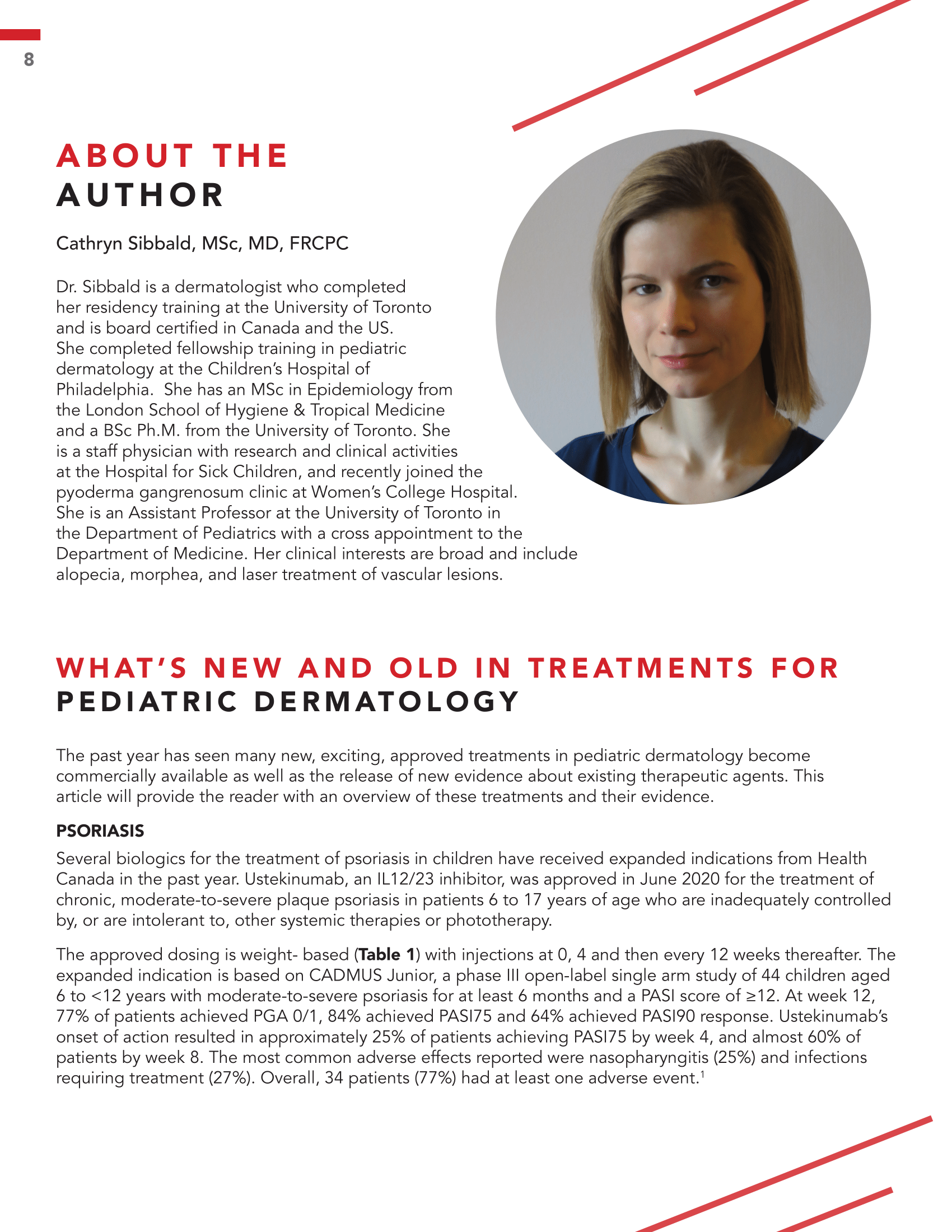What’s new and old in treatments for pediatric dermatology
Abstract
Several biologics for the treatment of psoriasis in children have received expanded indications from Health Canada in the past year. Ustekinumab, an IL12/23 inhibitor, was approved in June 2020 for the treatment of chronic, moderate-to-severe plaque psoriasis in patients 6 to 17 years of age who are inadequately controlled by, or are intolerant to, other systemic therapies or phototherapy.
The approved dosing is weight- based with injections at 0, 4 and then every 12 weeks thereafter. The expanded indication is based on CADMUS Junior, a phase III open-label single arm study of 44 children aged 6 to <12 years with moderate-to-severe psoriasis for at least 6 months and a PASI score of ≥12. At week 12, 77% of patients achieved PGA 0/1, 84% achieved PASI75 and 64% achieved PASI90 response. Ustekinumab’s onset of action resulted in approximately 25% of patients achieving PASI75 by week 4, and almost 60% of patients by week 8. The most common adverse effects reported were nasopharyngitis (25%) and infections requiring treatment (27%). Overall, 34 patients (77%) had at least one adverse event.
References
Philipp S, Menter A, Nikkels AF, et al. Ustekinumab for the treatment of moderate-to-severe plaque psoriasis in paediatric patients (>/= 6 to < 12 years of age): efficacy, safety, pharmacokinetic and biomarker results from the open-label CADMUS Jr study. Br J Dermatol. 2020;183(4):664-672.
Bodemer C, et al. Secukinumab demonstrates high efficacy and a favourable safety profile in paediatric patients with severe chronic plaque psoriasis: 52-week results from a Phase 3 double-blind randomized, controlled trial. Journal of the European Academy of Dermatology and Venereology. 2021 Apr;35(4):938-947.
Paller AS, et al. Efficacy and safety of ixekizumab in a phase III, randomized, double-blind, placebo-controlled study in paediatric patients with moderate-to-severe plaque psoriasis (IXORA-PEDS). British Journal of Dermatology. 2020 Aug;183(2):231-241.
Paller AS, et al. A retrospective cohort study to evaluate the development of comorbidities, including psychiatric comorbidities, among a pediatric psoriasis population. Pediatric dermatology. 2019 May;36(3):290-297.
Simpson EL, Paller AS, Siegfried EC, et al. Efficacy and Safety of Dupilumab in Adolescents With Uncontrolled Moderate to Severe Atopic Dermatitis: A Phase 3 Randomized Clinical Trial. JAMA Dermatol. 2020;156(1):44-56.
Paller AS, Siegfried EC, Thaci D, et al. Efficacy and safety of dupilumab with concomitant topical corticosteroids in children 6 to 11 years old with severe atopic dermatitis: A randomized, double-blinded, placebo-controlled phase 3 trial. J Am Acad Dermatol. 2020;83(5):1282-1293.
De Wijs LEM, Thyssen JP, Vestergaard C, et al. An approach for the transition from systemic immunosuppressants to dupilumab. J Eur Acad Dermatol Venereol. 2021;35(3):e221-e223.
Bansal A, Simpson EL, Paller AS, et al. Conjunctivitis in Dupilumab Clinical Trials for Adolescents with Atopic Dermatitis or Asthma. Am J Clin Dermatol. 2021;22(1):101-115.
Agnihotri G, Shi K, Lio PA. A Clinician’s Guide to the Recognition and Management of Dupilumab-Associated Conjunctivitis. Drugs R D. 2019;19(4):311-318.
Cheng J, Jiang L, Morrow NC, et al. Recognition of Atopic Keratoconjunctivitis During Treatment with Dupilumab for Atopic Dermatitis. J Am Acad Dermatol. 2020.
Uchida H, Kamata M, Nagata M, et al. Conjunctivitis in patients with atopic dermatitis treated with dupilumab is associated with higher baseline serum levels of immunoglobulin E and thymus and activation-regulated chemokine but not clinical severity in a real-world setting. J Am Acad Dermatol. 2020;82(5):1247-1249.
Jaros J, Hendricks AJ, Shi VY, Lio PA. A Practical Approach to Recalcitrant Face and Neck Dermatitis in Atopic Dermatitis. Dermatitis : contact, atopic, occupational, drug. 2020;31(3):169-177.
Bax CE, Khurana MC, Treat JR, Castelo-Soccio L, Rubin AI, McMahon PJ. New-onset head and neck dermatitis in adolescent patients after dupilumab therapy for atopic dermatitis. Pediatr Dermatol. 2021.
Draelos ZD, Ports WC, Vlahos B, et al. Skin permeation and penetration of crisaborole when coapplied with emollients. J Am Acad Dermatol. 2020;83(6):1801-1803.
Tan J, Thiboutot D, Popp G, et al. Randomized phase 3 evaluation of trifarotene 50 mug/g cream treatment of moderate facial and truncal acne. J Am Acad Dermatol. 2019;80(6):1691-1699.
Blume-Peytavi U, Fowler J, Kemeny L, et al. Long-term safety and efficacy of trifarotene 50 mug/g cream, a first-in-class RAR-gamma selective topical retinoid, in patients with moderate facial and truncal acne. J Eur Acad Dermatol Venereol. 2020;34(1):166-173.
Cosio T, Di Prete M, Gaziano R, et al. Trifarotene: A Current Review and Perspectives in Dermatology. Biomedicines. 2021;9(3).
Roberts EE, Nowsheen S, Davis DMR, Hand JL, Tollefson MM, Wetter DA. Use of spironolactone to treat acne in adolescent females. Pediatr Dermatol. 2021;38(1):72-76.
Arthur M, Fett NM, Latour E, et al. Evaluation of the Effectiveness and Tolerability of Mycophenolate Mofetil and Mycophenolic Acid for the Treatment of Morphea. JAMA Dermatol. 2020;156(5):521-528.
Martini G, Saggioro L, Culpo R, Vittadello F, Meneghel A, Zulian F. Mycophenolate mofetil for methotrexate-resistant juvenile localized scleroderma. Rheumatology (Oxford, England). 2020.
Phan K, Lee G, Fischer G. “Methotrexate in the treatment of paediatric alopecia areata: Retrospective case series and updated meta-analysis.” Australasian Journal of Dermatology. 2020 May;61(2):119-124.
Kinoshita-Ise M, Sachdeva M, Martinez-Cabriales SA, Shear NH, Lansang P. Oral Methotrexate Monotherapy for Severe Alopecia Areata: A Single Center Retrospective Case Series. J Cutan Med Surg. 2021 Sep;25(5):490-497.
McKenzie PL, Castelo-Soccio L. Dupilumab therapy for alopecia areata in pediatric patients with concomitant atopic dermatitis. J Am Acad Dermatol. 2021.
Ikeda T. A new classification of alopecia areata. Dermatologica. 1965;131(6):421-445.


